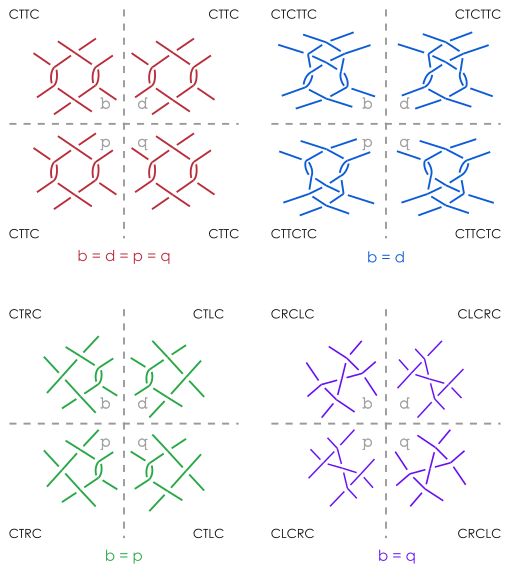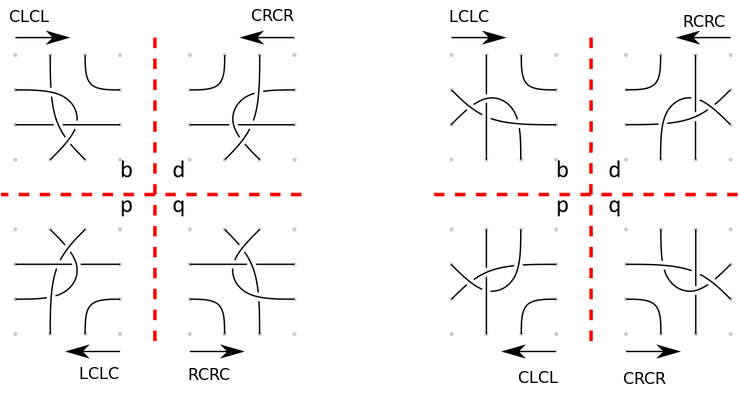
Mirrored and rotated stitches.
Soundless video clip.
The clip shows that the buttons ↔ and ↕ change the text field.
It subsequently assigns the text value to stitches in the pair diagram.
Symmetry
Table of contents
Symmetry on a diagonal net
Just an example of mirrored stitches placed on a diagonal net. The diagram on the right shows the working directions of the stitches.

What the flip buttons do
Mirrored representation: b ⇔ d, p ⇔ q
a. Replace each R in the with L and each L with R
CTCRC ⇒ CTCLC
Mirrored representation: b ⇔ p, d ⇔ q
a. Read backwards
CTCRC ⇒ CRCTC
CTRCTLC ⇒ CLTCRTC
How to make the quartet of stitches
a. Apply mirror b ⇒ d
b. Apply mirror d ⇒ q
c. Apply mirror q ⇒ p
CTCRC ⇒ CTCLC
CTRCLC ⇒ CTLCRC
Internal symmetry
The following examples produce less than four different stitches by mirroring.

The mirrored representations of b and d are identical if b has no left or right twist actions (only T, no R and no L). b=d in the picture above. The mirrored representations of b and p are identical if b is a palindrome. b=p in the picture above. All mirrored representations d, q, p, b are identical if b has no left or right twist and is a palindrome. b=d=p=q in the picture above.
Symmetry on a horizontal net
The working directions in a horizontal net cause challenges when flipping stitches.

In the diagrams above, b and q can only be executed on a left to right row, d and p on a right to left row. Compare b of the left diagram with p of the right diagram: only changing the working direction rotates the stitch by 45 degrees in a clockwise direction. Compare both b’s, and we see that reading the stitch instructions backwards has the same effect.
The algorithm for the flip buttons assumes stitches are placed on diagonal rows. Applied in horizontal rows we need the following rules to avoid rotations:
- After the both button: apply in a row with the same direction.
- After a
↔or↕: apply in a row in opposit direction.
Wrapping up
The stitches above were drawn manually. Below screenshots of GroundForge annotated with dashed lines.
You can reproduce the thread diagrams B and D on this nets page with stitch crcllc: click/tap horizontal: b+d+p+q and diagonal: b+d+p+q. We are talking about the first diagram in each group. For the pair diagrams A and C you need to click the links in the diagram captions.
Direct links for the pair diagrams: A+B and C+D.
The fat arrow heads indicate working directions. Each blue dashed line indicate flip axis. The red dashed line in D is not a flip axis. From this we see that de vertical mirror in pair diagram C is deceptive. The pinkish arrows show how the stitches in B rotate by 45 degrees in D.